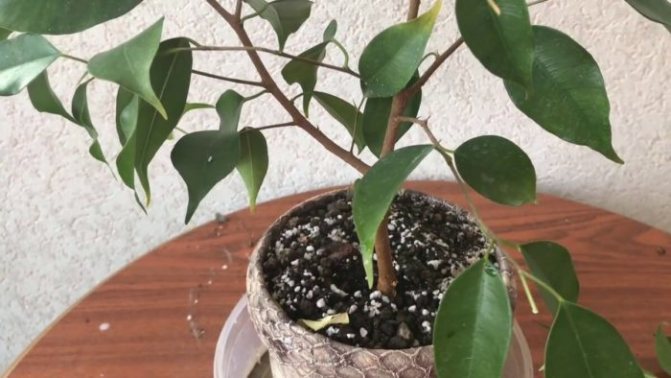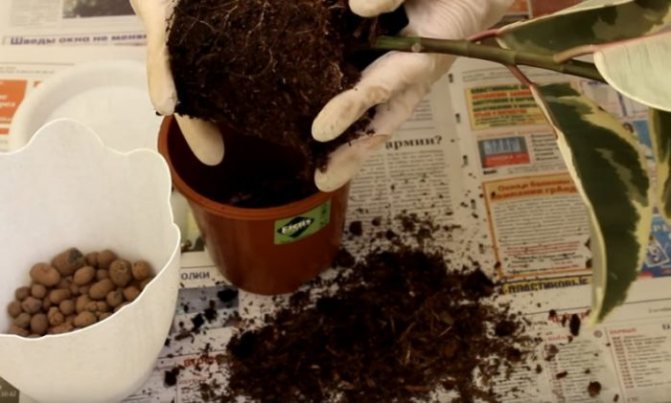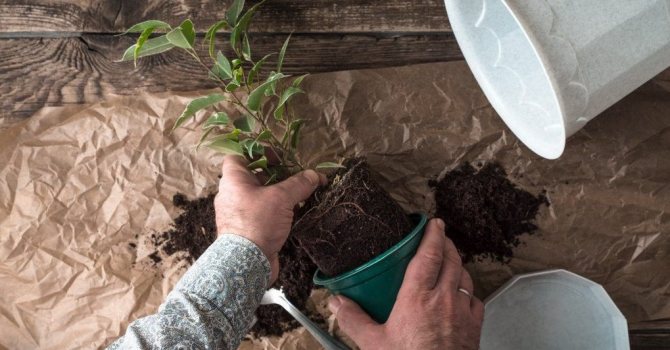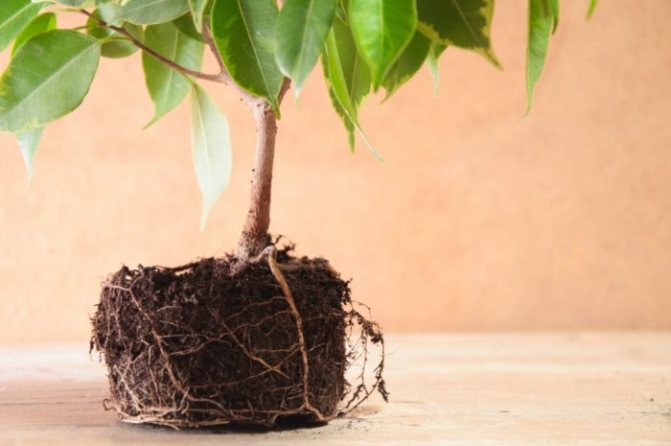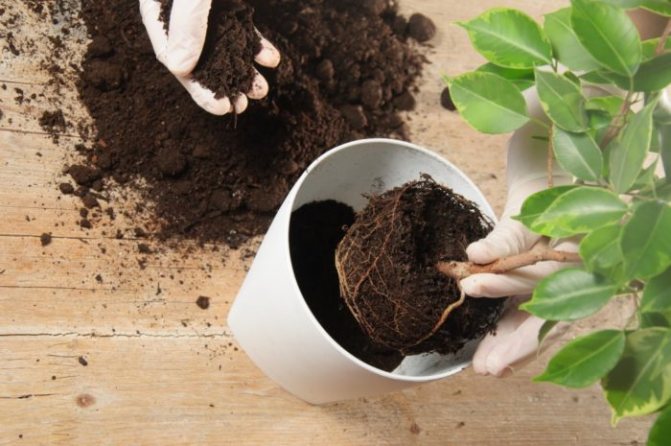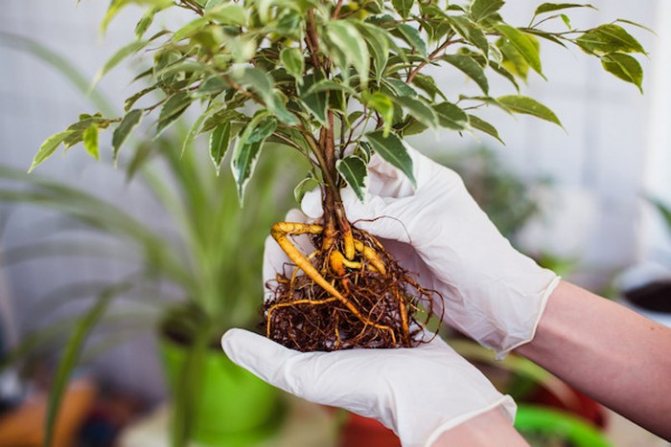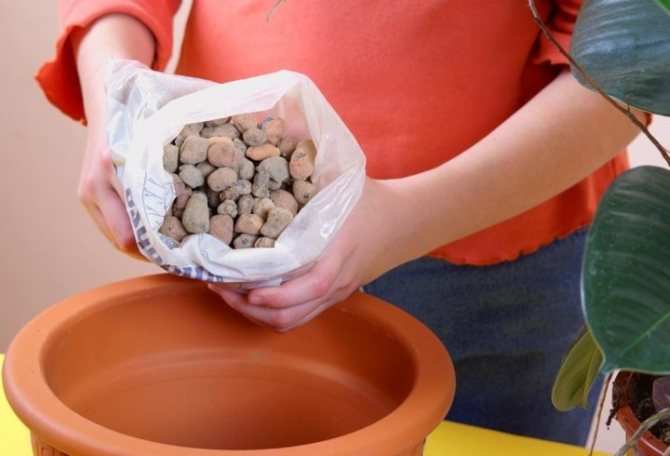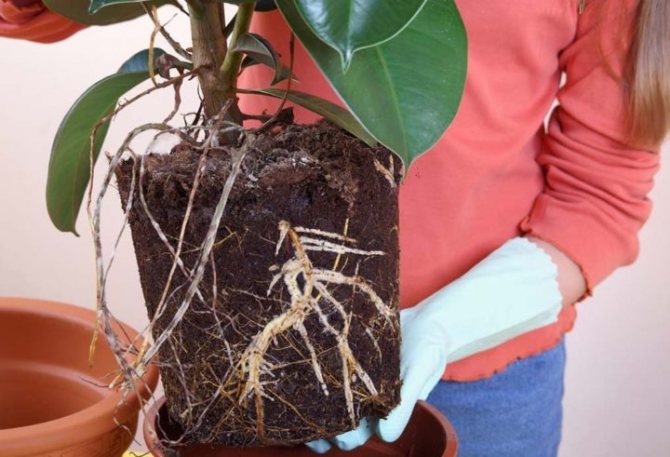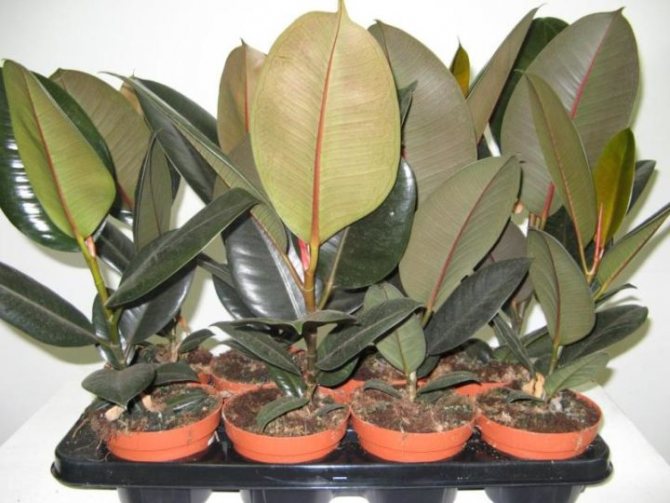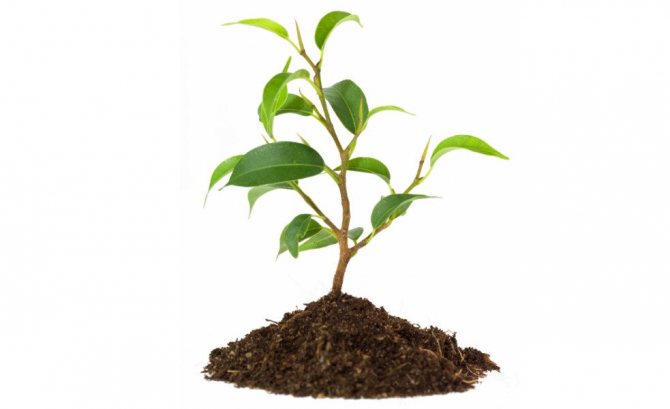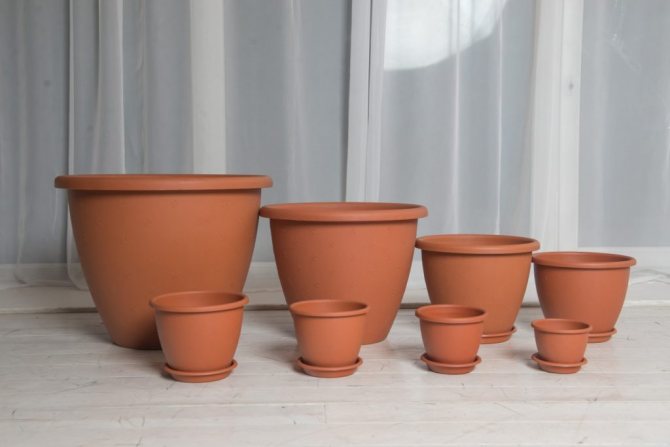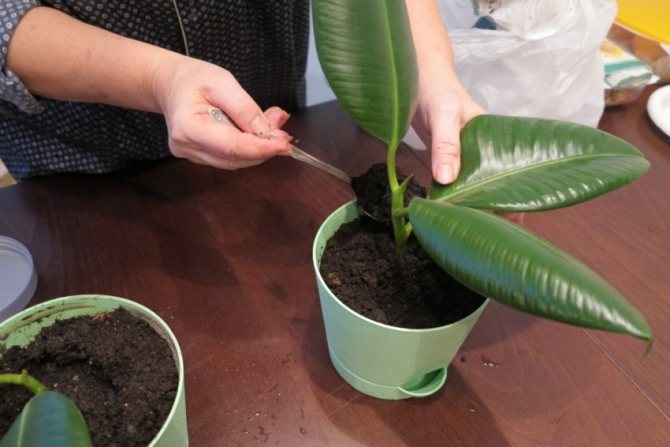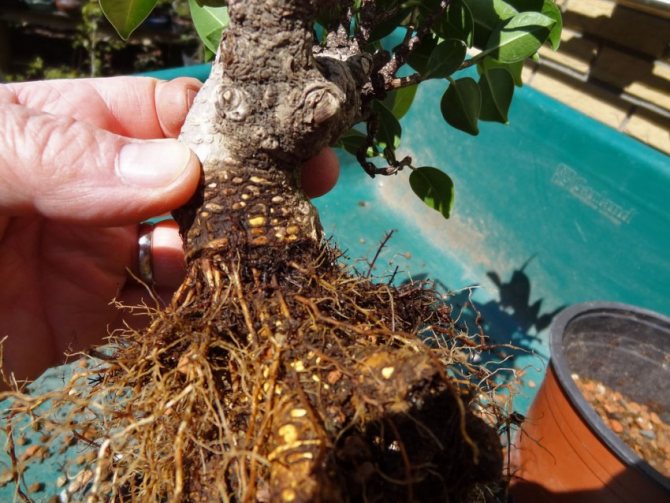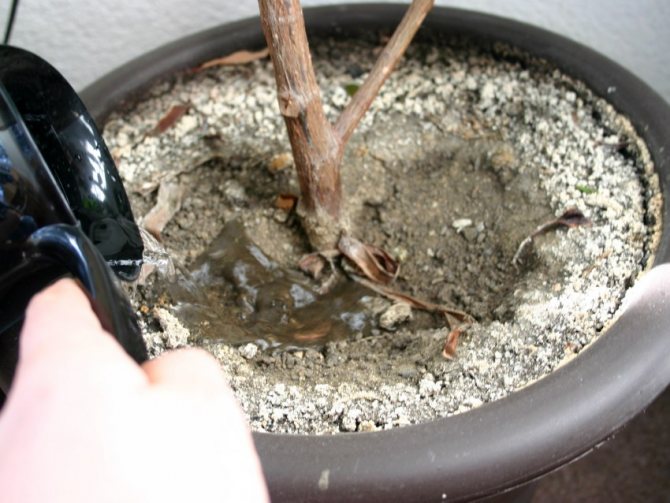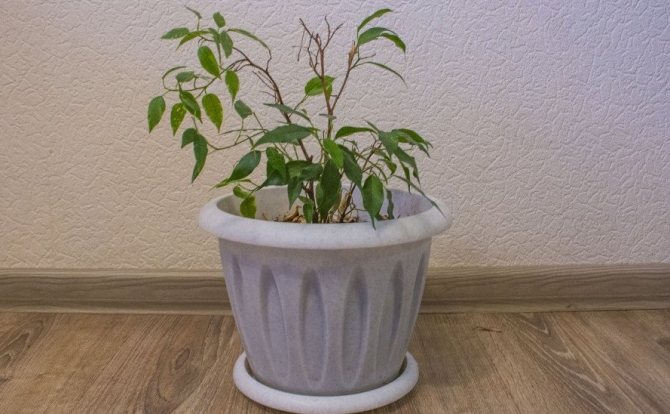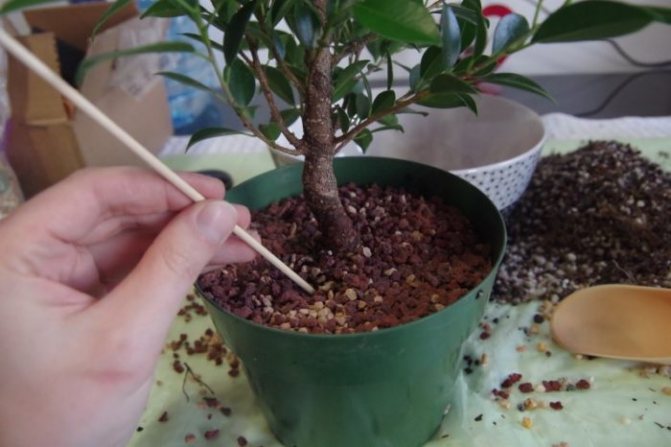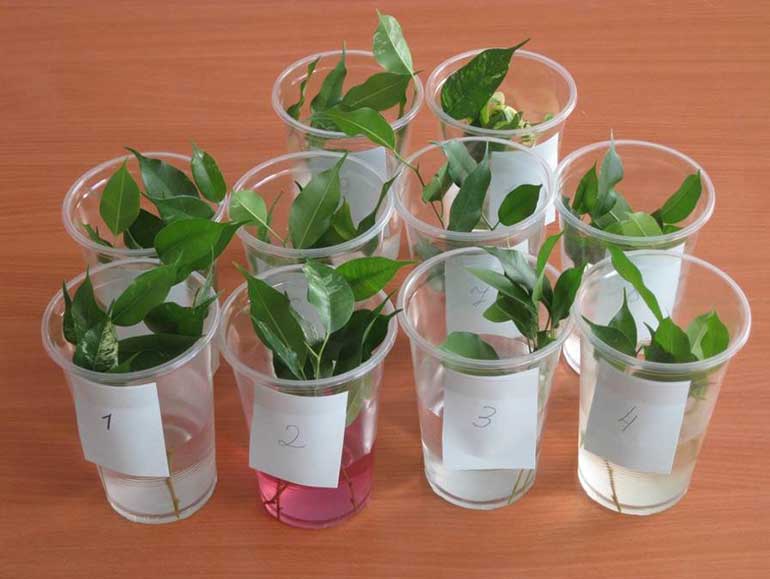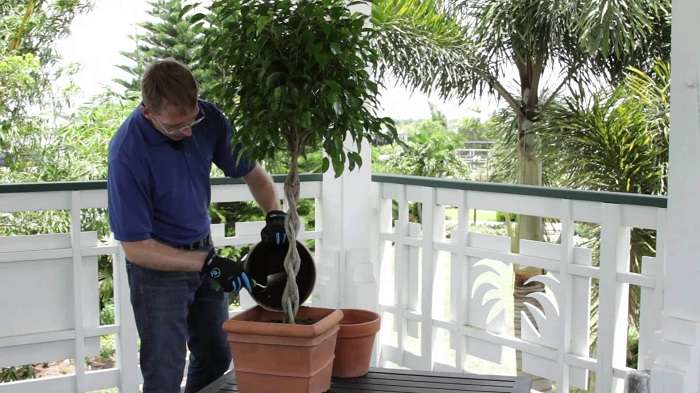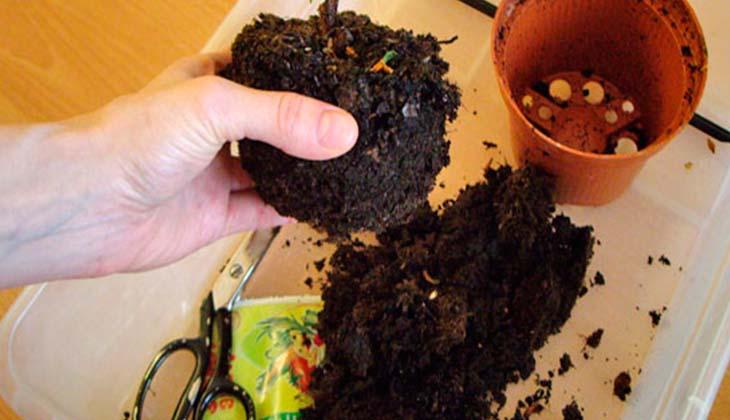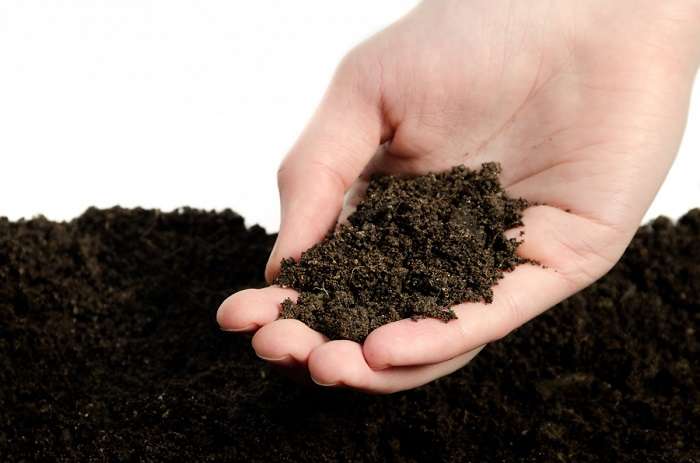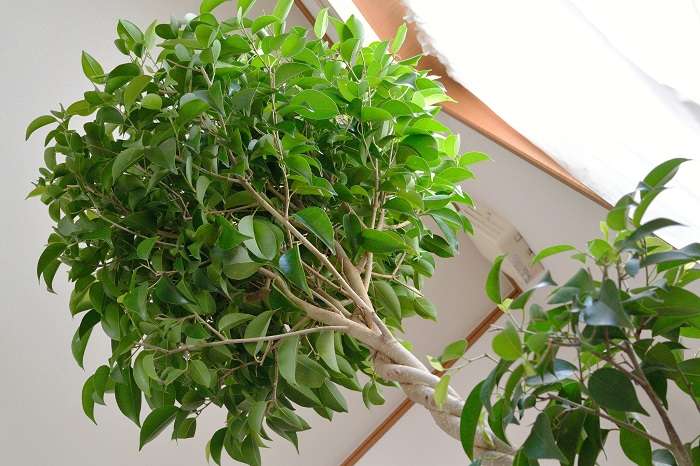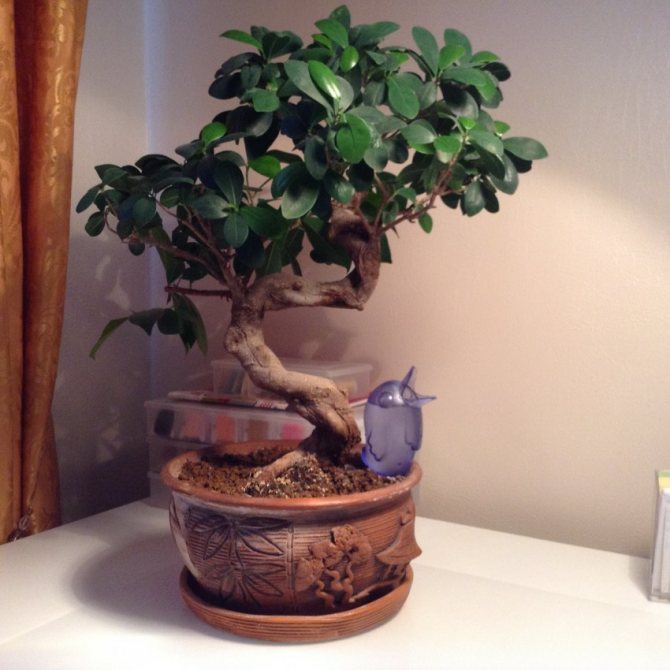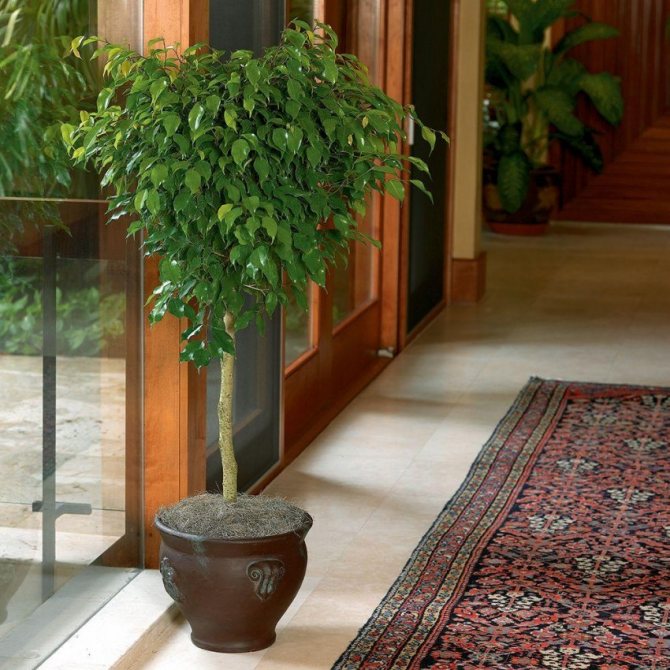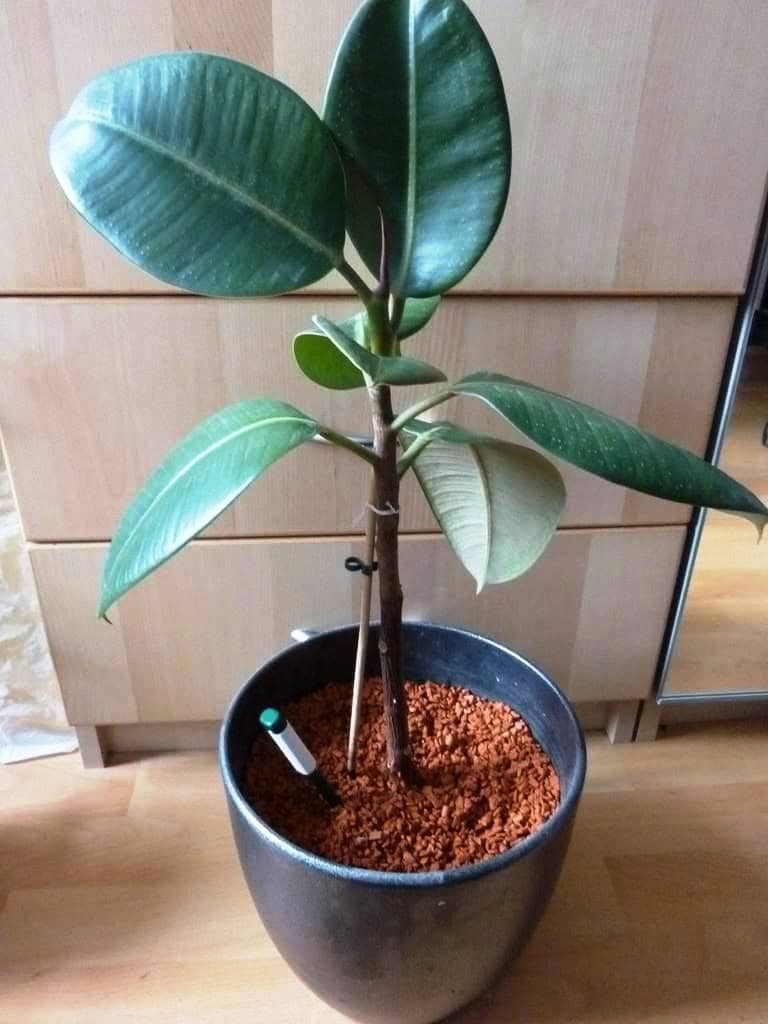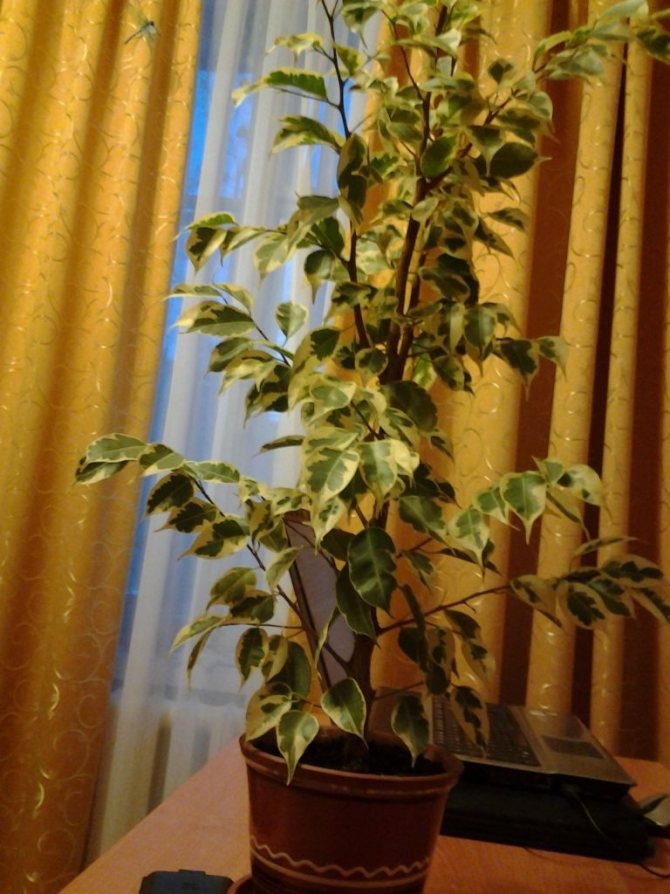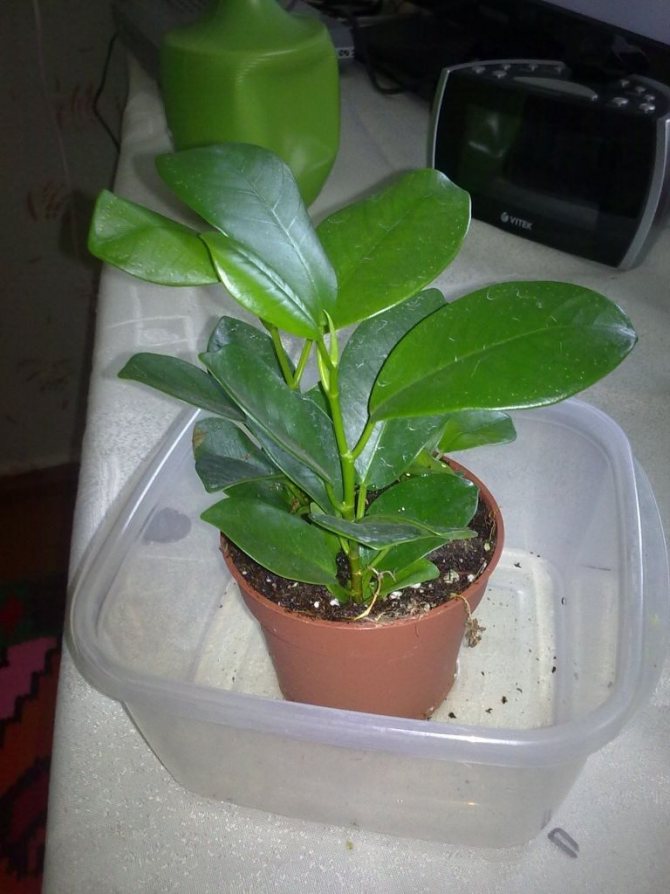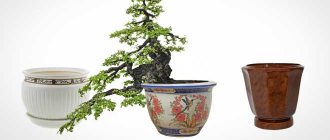Not all indoor crop lovers know how to transplant Benjamin's ficus at home, since the plant is exotic for the latitudes of Russia. Ficus benjamina of the mulberry family grows in tropical and subtropical forests in China, Southeast Asia and India. It is also found in Australia and the Philippines.
Even a small indoor ficus looks like a small tree with a short trunk, smooth light beige bark and a highly branched crown. Since this plant is native to the tropics, it has a large number of characteristic aerial roots. This beautiful evergreen tree in nature can grow up to 30 m in height. Its smooth oval-oblong leaves can be from 6 to 13 cm long and 2 to 6 cm wide. The leaves have a strongly pronounced main vein compared to the barely noticeable 8-12 pairs of lateral veins.
Ficus Benjamin has a developed strong root system, but gardeners should remember that it is very fragile, so you need to be careful when transplanting it. Its roots spread both in depth and on the surface of the earth.
Indoor small ficuses are of various varieties, which differ in size, shape, color of leaves, etc.
Ficus transplant how it happens
After the desired flowerpot has been selected, all the appropriate manipulations described above have been carried out, you can finally transplant the ficus into another pot. To do this, put a little expanded clay on the bottom of the flowerpot, add a substrate and plant a flower. It would seem that everything is so simple, but you should not rush. Before placing the roots in a container, you must carefully examine them.
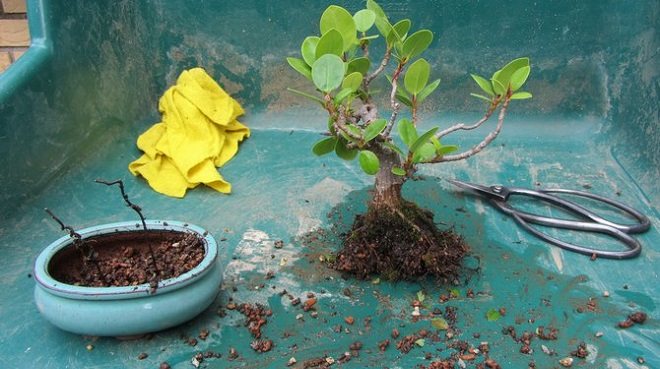
Considering that the flower was probably in another pot before, the roots are completely "covered" with earth. Therefore, you will need to take paper, put a plant on it and tap the whole earth from the bottom.
Important! The "tapping" procedure must be carried out very carefully, because the root system can be damaged. ... The roots that appear will need to be carefully checked.
If they do not become limp in their hands, have different color shades (yellowish, whitish, flesh or brownish), then everything is fine with the root system. Otherwise, you will need to remove decayed or diseased roots, then dry the remaining ones and treat them well with fungicidal agents.
The roots that appear will need to be carefully checked. If they do not become limp in their hands, have different color shades (yellowish, whitish, flesh or brownish), then everything is fine with the root system. Otherwise, you will need to remove decayed or diseased roots, then dry the remaining ones and treat them well with fungicidal agents.
Next, you will need to directly place the plant in a new pot. It is very important to ensure that the roots are not pressed against the bottom of the container. Many inexperienced growers try to tamp the root system as much as possible, fearing that individual roots will begin to "dangle". This will not happen if you correctly and carefully distribute the substrate over the pot, and then crush it a little.After the flower has been placed, you can add potting soil, pressing it down a little so that the flower starts to hold well.
Having successfully transplanted rubber ficus or another variety of this plant, it will be possible to water the flower a little. It is not worth pouring it in, because the earthen lump located around the rhizome may begin to rot. Regardless of which pot the handsome man has moved into, it will still need to be transplanted from time to time. Best of all, of course, the transshipment method is suitable, when the "wound" soil remains on the roots of the ficus. In this case, it is much easier for him to postpone the procedure.
However, experienced flower growers say that this does not happen very often. In recent years, plants are increasingly sick, therefore, in order to prevent it, it will not be superfluous to carry out a large-scale manipulation (with the replacement of all soil), especially since how to transplant Benjamin's ficus was described above.
Often, after the procedure, the flower begins to turn yellow or shed its leaves. Do not be afraid of this, because it is absolutely normal. Everything will be back to normal in a couple of weeks.
If this does not happen, it means that the transplant of the rubber plant was carried out incorrectly, or some problems arose with the substrate. In order to prevent the occurrence of troubles, it will not be superfluous to learn about some tricks.
Pot size - how to choose it
Some believe that Benjamin's ficus pot can be anything. Even the one that remains from some other flower, for example, will do. If you act on this principle, then you can face the fact that the plant stops growing, begins to wither, and then dies altogether.
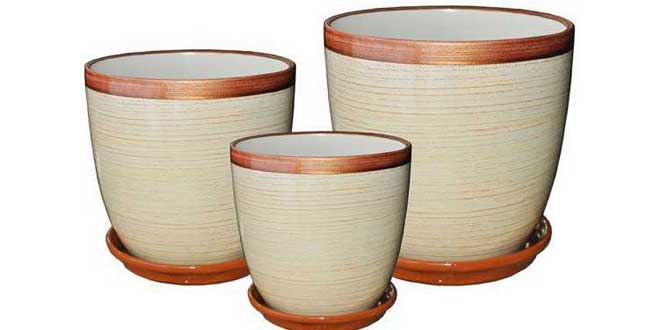

Experienced growers say that "We choose the size depending on the development of the roots of the flower." Young plants that have small roots do not make sense to plant in large flowerpots, since the ficus will stop growing, due to the fact that the root system begins to actively develop. And until it wraps around the entire earthy clod, the situation will not change.
However, this does not mean that you should wait until the roots have already emerged from the drainage holes.
If the flower has not been transplanted for more than a year, it is necessary to get an earthen lump together with the flower and carefully examine it. Noticing a developed root system, it is necessary to transplant the ficus into a pot, which will be several centimeters larger than the previous one.
Important! Rubbery ficuses grow very quickly, so they will have to buy a new pot every year.
The mistake of many gardeners is that, when planning to plant a tree, they transplant an already large enough flower into a container that is slightly larger than the previous one. This rule must be observed for those flowers that grow on the windowsill. For outdoor ficuses, you should buy large enough flowerpots. Considering that adults and large plants are not transplanted, they simply change the top layer of the substrate every year, it will be very difficult to transplant a flower into a larger pot. The plant may simply not take root in a new place and die.
Pot
Any pot made of various materials is suitable for this flower, the most important thing is that the chemical composition of the container does not affect the flower itself and its root system. In addition, the flower pot is also selected according to external data, so that it emphasizes the existing interior.
As a rule, a clay, wooden or plastic pot is used to transplant a flower; for a young flower, a clay container should be used so that there is no coating on it. The advantages of such a pot are that it allows air and moisture to pass through, it is not recommended to put such a container in a place where there is the most bright light, as it will quickly heat up.As a result, the ficus will fade from the increased air temperature and heating.
When choosing a pot for Kinki, the size of the plant and its root system should also be taken into account. If a young plant is transplanted, then a small pot is suitable, for an older flower, you need to take a larger vessel, 10 liters. The container should not be too tight, but free for the plant, it is best if there is a drainage hole in it. Florists recommend using brick chips or expanded clay as drainage.
Advice! If you plan to transplant Benjamin at home, you need to select a pot that is wider in diameter than the previous container.
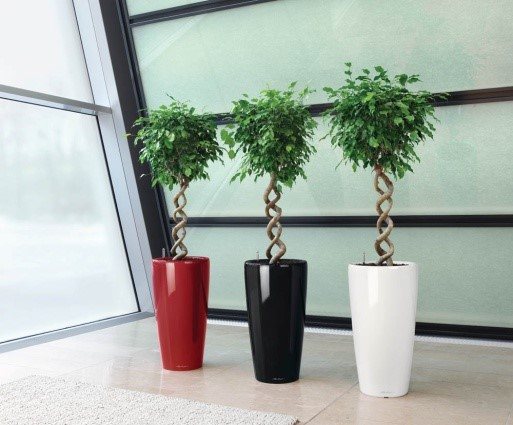

Material - what is better to pay attention to
Despite the fact that ficuses are quite unpretentious plants and can "live" in almost any pot, it is still recommended to pay attention to the material from which it is made.
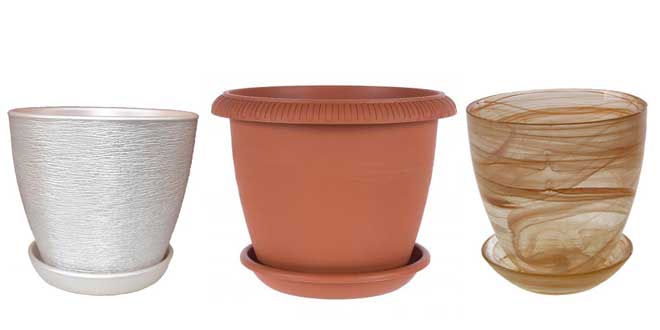

You need to understand that not all containers are safe, we are talking about toxic materials, from which flowerpots can also be made. Some manufacturers, in order to save a little on production, use poor quality plastics, which, when in contact with soil, water or fertilizers, begin to release toxins. It is the latter that adversely affect the plant.
There were cases when the flower began to fade gradually, but the reason could not be found. And only an accidental transplant into a new container saved the situation.
Therefore, when thinking about which pot you need for ficus, it is best to choose proven materials.
These include:
The latter material is relevant for the manufacture of large tubs that can decorate any room.
As for the clay containers, they are usually used for planting bonsai.
Ceramics is an expensive material, but beautiful, durable and, of course, natural, so if possible, you should pay attention to it.
Read also: Catalpa in the suburbs reviews
If the florist is familiar with the manufacturing company and has repeatedly bought the pots of the presented company made of plastic, then you can purchase them as well. At the same time, having noticed some negative changes occurring with the flower, as well as eliminating all possible problems, it will not be superfluous to change the flowerpot by buying a pot made of natural material.
Problems when growing ficus
Ficus Benjamina has some growing difficulties that you need to pay attention to:
- Dry leaf tips in winter indicate a lack of humidity in the room. Most often this is due to the shutdown of heating. In this case, it is necessary to increase the frequency of spraying and arrange artificial lighting. This will help the flower wait for spring.
- If the plant suddenly begins to shed its leaves, this should alert its owner. So the flower can react to sudden changes in the conditions of detention, for example, to a decrease in temperature, the appearance of a draft, a change of place, abundant watering in winter, when it was necessary, on the contrary, to reduce the amount of moisture.
- Changing seasons in any plant causes yellowing and shedding of leaves. Ficus is no exception. But if at another time Benjamin's ficus turns yellow - what to do? There are two main reasons why this happens: the first is an excess of water that can kill the plant, and the second is too low a temperature. It is necessary to eliminate these reasons.
- If the flower does not grow or develop for a long time, you need to assess whether the size of the pot is correct. If the pot is too large for the size of the plant, the roots will wither, stop developing and die. On the contrary, the tight capacity prevents the formation and development of the crown.
If, after correcting mistakes in the care and maintenance of the flower, there is no improvement, you need to pay attention to the presence of diseases and pests.
What color to give preference
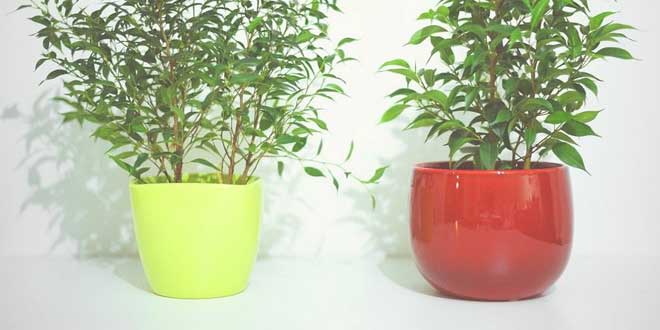

Perhaps this is the simplest thing that can be. Today there are so many colors on the market that it will not be difficult to choose a suitable pot for ficus. Some gardeners advise paying attention to light colors that harmonize very beautifully with the green shades of the leaf plates. If you are purchasing a ceramic flowerpot, then you can take a closer look at products that have a fancy and delicate pattern.
By choosing the right flowerpot, the flower will grow quickly enough and develop well.
Ficus is not a very whimsical plant. But the growth rate of the flower and the density of the crown are directly related to the characteristics of the pot in which it lives. Therefore, when buying a container for growing a tree, certain nuances must be taken into account.
Diseases and pests of ficus
Among the most common diseases affecting Benjamin's ficus are the following:
- Anthracnose. Dark brown spots appear that develop into ulcers. If untreated, the ficus will die. Control methods: removal of affected leaves, fungicide treatment, reduction of spraying and watering, frequent ventilation.
- Tserkoporosis. Black small dots appear behind the leaf. Treatment is the same as for anthracnose.
- Dropsy. With this disease, cork growths are formed on the back of the leaf. Treatment: Removing diseased leaves and providing proper care.
The main pests of Benjamin's ficus are spider mites, thrips and aphids.
What kind of soil is needed?
The soil should be nutritious, moisture-permeable, have good aeration, and have neutral or weak acidity (pH 5.5–6.5).
You can use store-bought soil intended for growing decorative deciduous plants or ficuses, or prepare your own soil mixture by mixing:
- turf;
- coarse sand;
- peat;
- leafy ground.
The risk of root rot can be minimized by adding charcoal to the soil.
To get rid of pests, the soil mixture must be ignited, steamed and spilled with a manganese solution.
Reproduction
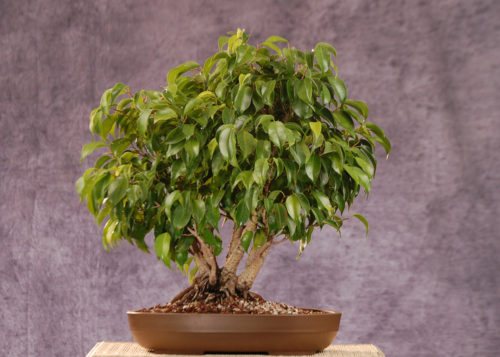

This perennial propagates by cuttings, layering and seeds. Depending on the chosen method, you will need:
- secateurs;
- soil mixture;
- containers for planting;
- growth stimulants - "Kornevin", "Heteroauxin";
- polyethylene;
- sphagnum moss;
- charcoal or activated carbon;
- water;
- fungicides - "Bordeaux mixture", "Alirin B", "Fundazol".
By cuttings
The most common and easiest way. The most suitable time for this is spring or early summer, a period of active growth.
For grafting you need:
- cut cuttings 10-15 cm long;
- remove low-lying leaves;
- wash off the juice that has emerged, dry the cut sites, treat them with a growth stimulant ("Kornevin" or "Heteroauxin") to accelerate root formation;
- put the seedling in a container with settled water at room temperature, cover it with polyethylene, creating a greenhouse effect;
- when the roots appear, transplant the cutting into the ground and again cover the flowerpot with plastic or a jar until the first leaves appear.
Place the container with the seedling in a well-lit place at a temperature of + 25-30 ° C, excluding drafts and direct sunlight.
Layers
To reproduce in this way, you must:
- make an annular cut on the stem without touching the core of the wood;
- treat this area with a growth stimulant, wrap with wet sphagnum;
- cover the moss with polyethylene so that the moisture does not evaporate;
- fix the structure with threads or wire;
- after the roots appear, cut the stem slightly lower and plant in the soil;
- cut the place of cut with crushed charcoal or activated carbon.
Layering propagation is most often used in bonsai cultivation to obtain aerial roots.
Seeds
Seeds must be treated with a growth stimulant and fungicides (Bordeaux mixture, Alirin B, Fundazol), sown superficially on light moist soil. Cover the container with polyethylene and keep at a temperature of + 25-30 ° C and sufficient light.
This method is used by professional breeders to obtain new varieties and hybrids.
How to prepare for boarding
There are several ways to propagate ficus: by cuttings, using an aerial shoot or leaf.
A stalk for subsequent planting is chosen with 3-4 leaf nodes (10-15 cm long), no longer green, but still quite flexible. With a sharp knife or blade, cut it off at an angle of 45 degrees. Then you need to remove the emerging juice from the cut, otherwise it can interfere with the appearance of roots or even lead to rotting of the appendix.
If you take a stalk from a branch that is already quite stiff, it is advisable to split it at the cut and stick matches there so that the parts of the stem do not touch. It will not be possible to propagate ficus with green cuttings - with a probability of 99% they will simply rot. Places of cuts must be disinfected with activated carbon, ground into powder, and, if possible, with a rooting agent.
When propagating with a leaf, the system is almost the same, only a very small stalk with one leaf is required. If you take just a single leaf, it may even give roots, but a new plant will not grow out of it, since the future plant grows from a bud in the leaf axils.
Both types of cuttings can be rooted both in water and in the substrate. After cutting the cuttings with one or more leaves, it is recommended to twist them (not too tight) and tie them with a thread or ribbon, which will reduce the loss of moisture from the cuttings.
For bonsai
Bonsai is the ancient Chinese art of growing small copies of large trees. Ficus "Benjamina" is great for making bonsai at home. To do this, you need to choose the right pot, taking into account the aesthetics of the appearance of the plant and the characteristics of its growth. The bonsai pot should be flat and more like a tray. The height of such a bonsai tray is usually 10 cm and is optimal for the formation of the root system necessary for the plant. In the process of growth of the ficus in this technique, its trunk thickens, and aerial roots grow.
The width of the container often depends on the size of the plant's crown: the larger and wider it is, the larger the width of the bonsai tray should be. In the case of growing ficus bonsai, it should be noted that the surface of the root system is very small in relation to the aboveground part, and a container made of breathable materials such as wood or unglazed clay is best suited in this case. Most often, bonsai are grown in clay trays. Aesthetically, it looks very harmonious.
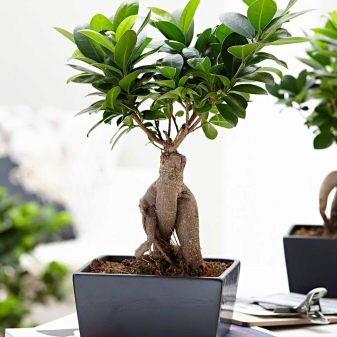

How to choose the right shape of the container
The ficus pot should be chosen depending on the size of the flower itself. If the plant has just been purchased and it is still small enough, then it is recommended to take a closer look at the small flowerpot.
You need to be much more careful when choosing a pot for a ficus tree, which has been growing at home for a long time.
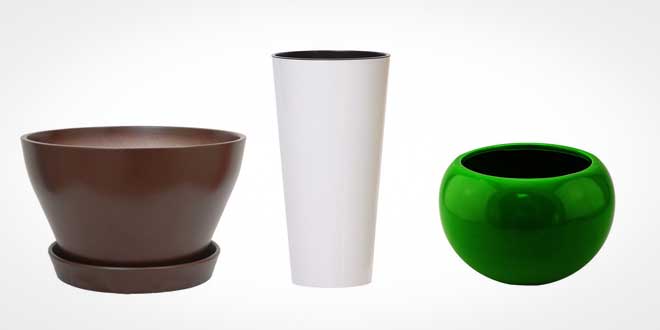

Experienced gardeners are advised to pay attention to containers of standard sizes, in which the diameter is equal to the height of the flowerpot. If there is a Rubber-bearing ficus or Benjamin's ficus at home, then such a pot will be an ideal option.
When planting a tree from which you want to create a bonsai, you need to understand that choosing a flowerpot will be a little more difficult. Many novice gardeners acquire what they like best based on their appearance, and this is fundamentally wrong.
Important! The bonsai pot should be flatter, resembling a plate, not a flowerpot.
A container or thicket is something that is in high demand.Besides the fact that such containers are very convenient, they will perfectly fit into any interior of an apartment or office.
When thinking about which pot to plant a flower in, you need to understand that any shape can be artificially changed. Of course, no one will specifically alter the container, but there is an opportunity to cheat by weaving a pots into which a vase can be placed. Tall products look beautiful and original, ideal for both bonsai and other forms.
Microclimate
Temperature and humidity
A comfortable temperature for the development of Benjamin's ficus is + 25-30 ° C in the spring-summer period, + 14-16 ° C in the cold season. If the thermometer drops to +10 ° C or below, the root system dies.
Ficus needs high air humidity: at least 50%, ideally about 70%. In autumn and winter it should be sprayed 2-3 times a week, in spring and summer - every day. Every month, for healthy growth and prevention of the appearance of pests, you need to arrange a warm shower for the ficus, having previously covered the earthen room with polyethylene.
Lighting and a comfortable place for a flower
Needs bright diffused lighting. Direct sunlight must be excluded from the plant - they lead to burns on the leaves and their yellowing.
In autumn and winter, with a short daylight hours, additional phytolamps are required.
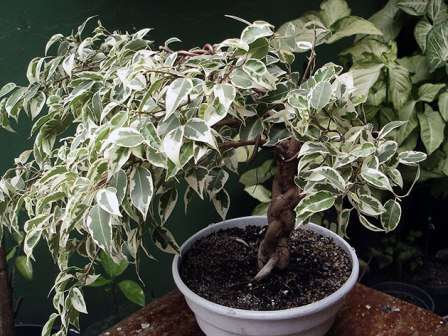

The most comfortable place for a ficus is a window facing east or west; in the south, shading will be required, especially at noon.
The room in which the plant is located should be regularly ventilated, and the flowerpot itself should not be located in a draft and near heating appliances.
The size
After purchasing a ficus, you need to evaluate its native pot and the availability of a stock of free space in it. If the roots of the plant are already getting cramped, then within a month it must be transplanted and not wait until the roots grow out through the drainage hole. In addition, the ficus itself increases in size, there is a possibility of the pot overturning, since the upper part of this plant can grow quite powerful. When choosing a pot for ficus, you must follow the 2 centimeters rule, that is, there should be 2 cm of free space for root growth. Otherwise, there is a risk of inhibition of plant growth, since the ficus will throw all its strength into building the root system, and only after filling the pot with roots, it will begin to grow above the ground. Also, too large a pot increases the likelihood of root rot, since in this case the likelihood of overflow increases.
Ficuses should be transplanted at the moment when the root system has completely filled the pot and met its walls. In the case of ficuses, the following rule or pattern can be derived: each subsequent pot should be 2 cm larger than the previous one. It should be borne in mind that some types of these plants grow incredibly quickly. For example, rubber-bearing ficus requires transplanting once a year, other species are transplanted once every 1 to 3 years. And also observations show that the older the plant, the less often it needs to be transplanted. If you think that the ficus has grown to the required size of the crown and root system, then you can carefully take it out of the pot, trim the roots and crown and return it back to the same pot, leaving the same 2 cm for the growth and development of the root system.
How to transplant ficus at home
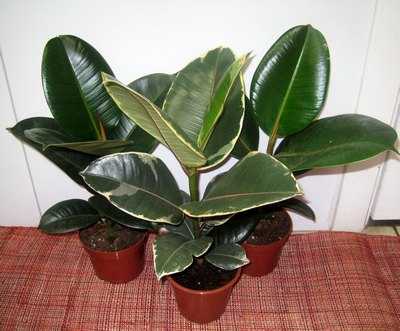

The evergreen ficus tree has been extremely popular for a very long time and is used to decorate the interior of an apartment, house, office or any other room. Reaching even an insignificant height, the ficus already looks like a small tree, which attracts most buyers - among all indoor plants, similar to flowers or bushes, the tree looks more than impressive.
In addition, the ficus lends itself well to various twisting and weaving.Its trunks are twisted in a spiral, braided, and intertwined with decorative supports. This gives it even more uniqueness and exoticism, and each owner or owner can create his own unique plant.
Ficus lends itself well to pruning, as a result of which it is easy to form a beautiful and lush crown. A popular method is to create a spherical crown on a spiral-wound trunk - it looks very unusual and spectacular.
Happy owners of this plant should know the basics of caring for it, so that the ficus will delight the eye with its appearance for a long time, grow quickly and not be exposed to diseases or pests. One of the important points is transplantation, and quite often the question of how to transplant ficus at home arises among novice flower growers.
In which pot to transplant ficus
First of all, especially for women, the question arises of which pot to transplant the ficus, because I want the container to be both beautiful and harmoniously fit into the interior, and provide a comfortable growth for the plant. Each next pot should be larger than the previous one by about 3-4 cm in diameter. There is no maximum allowable size, and especially large plants reach such sizes that a pot of 50 cm in diameter or even more is required.
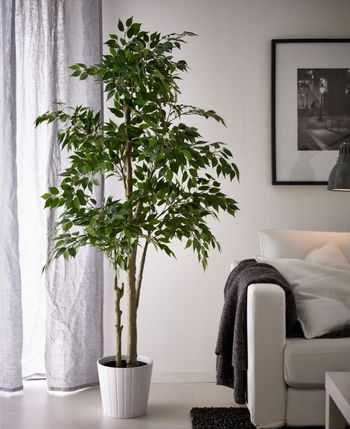

When is it better to transplant ficus
Before "replanting" the plant, you should determine when to transplant the ficus. To do this, you need to check for three signs:
- The potted soil is tightly rooted;
- After watering, the soil dries out very quickly;
- Roots protrude from the drainage holes at the bottom of the pot.
If all the signs are present (or one or two, but pronounced), it is worth starting the transplant process. In general, this procedure must be carried out every 2-3 years, however, other numbers can be heard from specialists when asked how often to transplant ficus, especially if the age of the plant is quite solid - old plants are transplanted every 4-5 years.
Do not disturb the plant simply because of the desire to change the pot, this will not affect its growth too well, so you should choose a pot that will suit any environment and will not get bored.
Rooting a plant
In order for the roots to appear on the handle, it can be placed in water or in the ground.
To root a sprout in water, you will need an opaque container - microscopic algae can multiply in the light in the water (this is because of them the walls of the vessel turn green), and this can lead to rotting of the roots of the appendix and its death. Additionally, it is advisable to throw an activated carbon tablet into the water. She herself must be well-settled or boiled, otherwise the harmful compounds contained in hard tap water can destroy the seedling. An important requirement: the leaves should not touch the water, otherwise they may start to rot.
The roots of the rooted twigs will be strong enough to transplant in about a month. You can also root cuttings with one leaf.
You can plant a shoot without roots immediately in the ground. In this case, it is still necessary to put the cutting in water for 2-3 hours, otherwise the milky sap will complicate the germination of roots on the shoot or even lead to the death of the planted plant. Next, the process should be planted in the ground. You will need a loose light earth with the addition of leafy earth, peat, sand. The soil should not dry out, so when we plant the shoot directly into the ground, it is advisable to germinate it in a mini-greenhouse.
Sprouts both in water and in the soil need the following care: an abundance of light without direct sunlight, no drafts or streams of hot air.
Rooting, as in the first case, takes about a month.
You can also breed ficus with the help of air layers.An adult houseplant with strong long branches, which has not given new green shoots for a long time, is best suited for this. By the way, pruning branches to obtain an airy shoot can also make the mother plant more aesthetically pleasing and rejuvenate it.
To plant Benjamin's ficus in this way, you need to choose a suitable branch, but do not cut it off, but only make a notch in a suitable place along the length or remove a small piece of bark. After washing off the milky juice, the wound on the ficus must be disinfected with the same coal powder, then apply wet sphagnum moss to it, wrap it with polyethylene and tie it to the trunk with twine, tape, wire, etc. At the same time, air must get inside the bag.
There are no difficult conditions for such a method of reproduction of ficus at home: you just need to make sure that the moss does not dry out (the drier, the lighter). The mother plant does not require special care. After about two months, the roots of the scion will become quite large and will grow through all the moss, becoming clearly visible through the bag. After that, you can separate the cuttings by cutting them just below the roots and plant a ficus.
How to transplant ficus
If the plant grows well, does not get sick, there is still a need for a ficus transplant. Usually for ficus, you can define the following terms of "moving":
- 3 year olds - once a year
- five-year - no more than once in a three-year period
- Older adults - once every six years
The new "apartment" is chosen about a couple of centimeters in volume, more than the old one.
In order for the transplant to be successful, you need to adhere to the following simple rules:
- Select the desired pot size and prepare it. Lay drainage (crushed stone, brick chips, etc.) at the bottom, cover with fresh earth
- To make the flower easy to get from the previous container, it should be watered.
- Select the top layer a little. Carefully, without damaging the root system, remove the ficus
- Slightly remove old soil from the roots
- Landing. Gradually fill up the voids, compacting evenly, not crushing too much.
- Drizzle.
- Subsequent watering can be started in a month. And during this period, it will be enough to spray a couple of times a day.
Your flower will not experience much stress if everything is done carefully and correctly.
Form for traditional ficuses
A pot for ficus should be chosen the most ordinary one, without any special structural refinements. It would be ideal to plant it in a container of the correct shape, which is created by the approximate equality of the parameters of height and width. This rule applies to almost all types of ficus, such as the "Benjamina" ficus and the rubbery ficus. At the same time, round pots should be avoided, since the roots of the ficus can be damaged during transplantation. When they are injured, the plants get very sick.
A pot that is too elongated is not suitable for ficus, since the volume of land in it will be much larger than required. If you love this shape, and it is necessary to create a stylish interior, then an elongated planter with a fake bottom at a higher level can be a way out.
How to care for Benjamin's ficus
Under natural conditions, Benjamin's ficus grows up to 25 m in height. The bark of this shrub has a dark gray color with transverse brownish strokes. The leaves are located on small petioles, have an oblong shape with a pointed apex. Ficus Benjamin leaves are smooth, glossy, alternating. Their length is from 4 to 12 cm, width is from 3 to 6 cm.
The central vein of the leaves is more pronounced in comparison with 8-12 pairs of weakly expressed lateral veins. The root system is invasive. The spread of the roots of the ficus Benjamin is characteristic both in depth and along the surface layer of the earth.
Indoor ficuses have a highly developed root system.Ficus Benjamin has a large number of different varieties, differing in size, shape, color of leaves, and also adapted for outdoor cultivation or keeping in an apartment.
Watering
When watering ficus Benjamin, it is not recommended to set a rigid schedule. It is necessary to take into account the age of the plant, lighting, air humidity, temperature, season. So, in the summer, watering should be moderate. Before each watering, the soil should dry out 2-3 cm deep. When watering, the water should pass through the drainage hole into the sump, then excess water can be drained. In winter, the plant does not need intensive watering, it is enough, if necessary, to properly water the ficus.
Water for irrigation should be taken settled or boiled (cooled to room temperature).
After such a procedure, in order to avoid hypothermia, it is worth leaving the ficus in the bathroom for a while.
Lighting
When caring for Benjamin's ficus, special attention should be paid to lighting, which affects the color of the leaves and the condition of the plant as a whole. Lighting in the place where the ficus is located should be: good (the plant loves bright and well-lit places); without direct sunlight (especially in summer). Diffuse light or partial shade is acceptable when breeding varieties of ficus with dark green leaves
Temperature
The most favorable temperature for keeping ficus is 20-25 degrees. It is necessary to avoid drafts, hypothermia from windows, window sills, open vents. In winter, ficus can tolerate significantly low temperatures - up to 16-18 degrees.
Humidity
Loves ficus Benjamin and high humidity, especially in the summer. Therefore, in the summer, it is recommended to regularly spray the crown of the plant with boiled water, cooled to room temperature.
In winter, it is important that the ficus is not in close proximity to the heating system. Ideally, if a device for maintaining air humidity or a can of water will be located next to the plant
The recommended air humidity for the content of ficus is 70%. Ficus Benjamin, like most other home-grown plants, loves feeding. For ficus, fertilizers are used in the spring and summer periods - every 2-3 weeks, from March to September. It is recommended to alternate mineral fertilizers with organic ones. In the spring, during the period of rapid growth, it is very important for the plant to use fertilizer with a maximum nitrogen content.
Material
The assortment list of pots offered by manufacturers for planting home flowers and plants is quite wide, as is the choice of materials from which they are made. Among them are containers made of ceramics, plastic, wood and even metal. Ficus is a rather picky flower in terms of the material of the container in which it grows. It feels great and develops well in both clay and plastic containers.
If there is a choice, then preference should be given to clay containers., not covered with a glossy glaze, since the clay has a porous structure, is breathable and improves root respiration. It should be borne in mind that over time, the clay pot can become covered with a white coating from the salts contained in the water, or turn green, since it absorbs moisture well. Also, the appearance of clay containers for flowers may seem unaesthetic.
A clay pot covered with glaze has a more attractive appearance than a product with a porous ceramic surface. However, such a container does not conduct light well and has a greater weight, which can make it difficult to care for the plant. If you decide to use glazed ceramics, take care of a sunny spot for the plant. At the same time, nothing terrible will happen if the ficus is planted in a plastic pot.At cost, it can be anything, the main condition is that the plastic does not emit substances harmful to the environment and plants. In addition, plastic products are brighter, with a beautiful design. The weight of the flower together with the earth in plastic is much less than in ceramics.
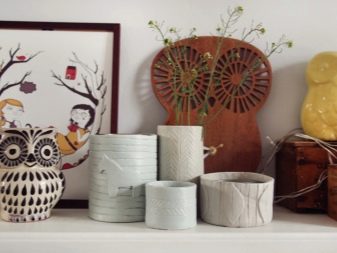

Glass plant pots are rare. If you come across a beautiful glass specimen, and you decide to plant your flower there, remember that this is a rather fragile vessel that requires careful handling. At the same time, it is worth paying tribute to the spectacular appearance of the glass container, which can be colored, transparent or matte. Wooden pots for ficuses are usually chosen in the form of a tub, in which the ficus fits very harmoniously into various natural and eco-styles. The tree is perfectly saturated with water, so often wooden tubs are used as pots, in which clay pots with ficuses are installed. Along with clay, wood is a natural material that excludes environmental pollution.
Read also: Potatoes under the straw reviews
It should be noted that during the selection and purchase of a pot for ficus, the presence of a drainage system is of great importance to drain excess liquid, which is detrimental to the root system of the plant. These pots are often designed with a spout to drain the water. In the absence of drainage in the pot, the risk of losing the plant is maximum, especially if it is made of materials that do not pass or absorb moisture, such as: glazed clay, plastic and glass.
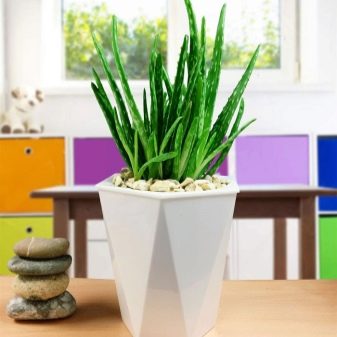

Choosing the right pot for ficus
If additional feeding is required, then you can apply spraying with a rather powerful tool - Epin.
In winter, Benjamin's ficus does not need feeding.
Watering
Watering Benjamin's ficus can only be done with warm water - 35-50 degrees, not often, so that the plant simply does not flood. The leaves of the tree need to be moistened by sprinkling with warm boiled water (then there are no streaks on the leaves). Dusty leaves lose their gloss - their natural shine, and the general appearance becomes unattractive. If possible, wipe the leaves of young plants with a damp sponge. A warm shower is an integral part of proper ficus care. It is recommended to rinse the plant every two to three weeks.
Creation of comfortable conditions
The optimal location of the ficus is in a bright and at the same time diffused light. It tolerates weak shading well, but bright sun rays are destructive for ficus.
In summer, the comfortable temperature for ficus is 17-20 ° C. The temperature in the autumn-winter period should not be lower than 18 ° С. The temperature and lighting in the room must be constant, otherwise their fluctuation can lead to yellowing and foliage. Moving the ficus to a new place is possible only as a last resort.
Where can one buy? Price fork
You can buy Benjamin's ficus in specialized stores or order online. The cost depends on its variety, height, diameter of the flowerpot and varies from 500 to 10 thousand rubles.
What to do right after buying a flower?
A newly purchased plant needs 15–20 days to adapt to new conditions, then it should be transplanted, replacing the transport container and substrate.
Expert opinion
Mokhov Andrey Petrovich
Graduated from KubSAU specialty: agronomy
Ficus does not tolerate frequent movements, so you should immediately choose a permanent place for it.
Pruning Ficus Benjamin
Pruning of a handsome indoor man is carried out during a period of active growth, this is April-June. The formation of the crown will make the plant attractive and stylish, and it will look harmonious in any interior. Young plants are the easiest to prune.
With timely formation, various types of crowns are obtained: spherical, bushy. When pruning, broken and old branches, as well as intersecting stems, are removed.Thinning the crown helps to avoid leaf fall and rejuvenates the tree.
For the successful formation of the crown, you must follow simple rules:
- Use sterile instruments;
- Before pruning a branch, you must imagine a plant without it;
- Do not damage leaves and bark;
- Carry out the cut obliquely;
- When pruning, leave a shoot with 4 or more leaves and a length of at least 20 cm;
- It is necessary to carry out pruning above the kidney;
- The cut gives off milk juice, which is removed with a damp cloth and powdered with charcoal.
Also, an interesting composition is created when several Benjamin's ficuses are planted in one tub. While the plants are young and flexible, it is easy to twist them into a plait or pigtail and fix them with a woolen thread. Weaving is carried out freely so that in the future the trunk can gain thickness.
How to choose a color
When choosing the color of the pot, you should take into account the style direction of the interior design and the color scheme of the room in which the pot with the plant will be located. Green ficus leaves are in perfect harmony with pots of white and light shades of various colors, as well as containers of brown clay with unusual patterns. To add brightness to the interior, it is diluted with bright yellow, bright green and pink pots. According to the teachings of Feng Shui, ficuses fill the atmosphere with tonic energy, which directs the inhabitants of the house in the right direction and makes them act more actively.
As for the choice of color according to Feng Shui, there is an opinion that one of the most suitable pots for ficus in terms of color is green, since it has a positive effect on the growth of well-being in the house, and attracts cash flows.
For information on how to properly transplant ficus into a new pot, see the next video.
Home transplant
A flower transplant should be left in the spring, if the flower is older than 3 years, then this procedure should be performed every year, if more, then once every 3 years. If the plant is even older in age, then it should not be replanted for at least 5 years. There are certain signs that indicate that it is time to transplant the ficus.
- The substrate dries quickly after watering.
- The ground is completely braided with ficus roots.
- From the drainage holes of the container, its root system is visible.
- Not only the soil, but also the pot itself is braided with flower roots from the inside.
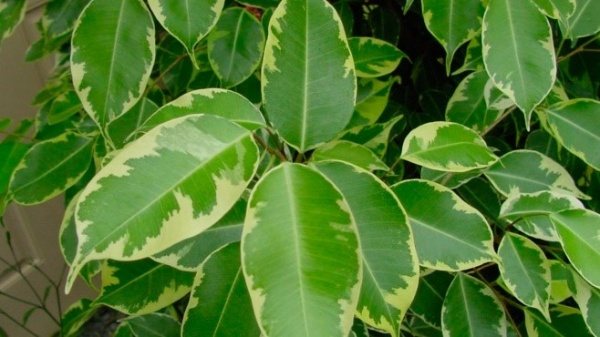

As a result of the perfect care of the flower by Benjamin kinky, the plant can grow quite quickly, a pot of 50 cm in diameter means that the plant can no longer be transplanted. In this case, it will be enough to remove a layer of earth from above every year and fill it with a new substrate, about 3 cm, do not forget to add fertilizers, about 20%.
Given the fact that the Kinki ficus loves cramped conditions, it is not recommended to transplant it into a pot that is too loose, in order to choose the right size, you can take it 3 cm larger in diameter compared to the previous vessel.
Ficus transplant is carried out in stages:
- The flower is removed from the old pot, if the root system looks out through the drainage holes, you must carefully remove them so as not to damage.
- Put drainage, expanded clay or brick shavings on the bottom of the container, pieces with a diameter of no more than 2 cm.
- Drainage is sprinkled on top with a small amount of substrate, using humus, peat or leaf soil. All elements are used in the same proportions.
- A flower is planted in a pot and all the free space is filled with a new substrate.
Sometimes, after the transplantation procedure, the Benjamin kinki flower can shed its leaves, this is a normal reaction, since there was a change in position, as a result, the plant received stress.
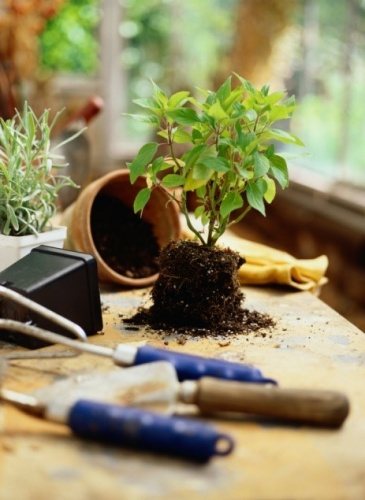

Is it possible to plant several flowers in one container?
Ficuses are often used in the interior design process. If you plant 2-3 shoots in one pot, you can form a beautiful composition from them.But for this you need to understand how to weave several trunks together correctly.
When planting several trees in one pot, the following guidelines must be followed:
- Choose indoor crops of the same height - within 15-17 cm.
- If the trunk is more than half stiff, such a plant is no longer suitable for creating a composition. During the weaving process, it can break.
- If there are only two plants, they can be braided in a spiral shape.
- In the case of using dwarf varieties, it is enough to twist the trunk once. For other trees, you can continue to twist their stems as they grow.
- Bulky or tall flowers require additional support for the period of weaving. Then the tree will be protected from distortions and falls. After completing the process, the frame can be removed.
- It is advisable to fix the contact points of the shoots with wire or strong threads. Then they are guaranteed to grow together in the required shape.
The most common type of weaving is the pigtail. It also belongs to the simplest and will be within the power of even a beginner. More experienced gardeners can try braiding the plants in a trellis or hedge.


Ficus is one of the most popular home and office plants. Its decorative shape fits into any interior and adds impact to any style. In care, these indoor plants are quite capricious, and their growth rate and appearance directly depend on the pot in which they grow.
Thus, a ficus pot is not only a place where it lives, but also a tool for shaping its appearance.
Pests. Table
| Pest | Signs | How to get rid of |
| Spider mite | White dots appear on the foliage, and on some parts of the plant - a thin web | Treat the ficus with "Fitoverm", "Aktellik", "Sunmight" |
| Thrips | Leaves turn whitish, pest eggs are visible on the lower part | Treat with insecticides ("Aktara", "Iskra", "Vermitek", "Mospilan") |
| Shields | A sticky coating appears on the leaves and trunk | Remove pests mechanically, using a cloth soaked in soapy water, then treat the plant with a systemic drug (Aktara), after 7-10 days spray it with an insecticide (Confidor, Komandor) |
Location in the house
Before bringing this plant into the house, it is necessary to determine its location - Benjamin's ficus, the photo of which is provided in the article, is very difficult to endure changing places, and after moving it most often drops foliage. If this trouble occurs soon after the purchase, then you should not be afraid and upset, since this is normal. Providing proper care for the plant will help it adapt. A place in the room must be chosen well-lit, but without direct sunlight. The plant does not like drafts and cold. The air temperature should be at least 15 ° С, relative humidity - 50-70%.
Cuttings and the process of reproduction with their help
Semi-lignified cuttings are a wonderful way to propagate and root seedlings in a warm spring at home. When propagating by cuttings, you need to achieve a length of 15 cm, cutting obliquely with a deviation of half a centimeter from the nodule. The leaf should be cut completely. To carry out the shenanigans, you need to use a garden knife, which will not be expensive. Each plant, injured under any conditions, secretes juice that tightens the wound and impairs the rooting process, therefore, as soon as the cut is completed, the cuttings must be immersed in liquid.
Soil and water work well with cuttings. In the second case, an opaque pot is chosen so that green algae do not develop. Rooting takes about 30 days, after the end of the process, the cuttings should be transplanted into separate pots.If the soil is used for rooting for transplanting the ficus, then it is necessary to keep the cuttings in water for a couple of hours in order to completely eliminate the juice. Then they are dried and planted in a sand-peat mixture with vermiculite.
The soil must be decontaminated with water vapor. When the cuttings are deepened, the soil reaches the next node after cutting. You can also use a mini greenhouse or a special terrarium with the desired temperature. New leaves that have appeared will tell you when you can transplant the ficus.
Fertilizers, feeding, stimulation
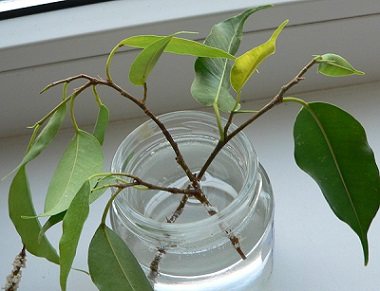

After the initial period of the rooting process, structural changes begin in the shoot, which affect several outer layers of tissue. Experienced growers recommend making 2-3 small cuts on the part of the cuttings that will be immersed in the ground. This speeds up the development of a young root system.
In addition to physical methods of stimulating root growth, there are also chemical methods. These include various types of fertilizers and dressings that are used to improve the functional state of flower tissues.
You can soak the lower part of the scion in a fertilizer solution for several hours, and then strengthen it on the ground. You can also apply a powder fertilizer to the cut instead of ash. This local application gives excellent results.
How to braid a "pigtail"
This method is not as simple as it might seem at first glance, but it is not impossible. How to plant Benjamin's ficus so that in the future you get such an interesting composition?
Weaving rules:
- Several shoots are selected and planted in one container next to each other. This will allow them to be woven neatly, and the final result will be aesthetic.
- When the side branches appear, they are cut off, leaving only the tops.
- Before the direct process of weaving, the flower is generously watered. The stems will be flexible and more amenable to manipulation.
- The braiding procedure takes several months. This is due to the slow growth rate of the trunk. First, they make several turns and tie the braided stems so that they do not disperse. You can leave gaps between the branches or place them tightly. It depends on personal preference. Some growers interweave the third stem, distinguishing it from others - there is no limit to imagination.
Crown formation
By pinching, pruning, interweaving branches and trunks, the plant can easily be given a varied appearance.
There are several most common ways to form a ficus crown, including:
- single and multi-tiered bole;
- bonsai;
- domed and spherical crown;
- various sculptures.
The formation of a tree is best done in the spring. It is easiest to form a young plant, since it grows actively and quickly. Pruning helps to awaken dormant buds, from which new shoots then grow and the plant becomes lush. In addition, with the help of pruning, you can refine a highly overgrown and unattractive ficus. Before this procedure, the pruner must be disinfected with alcohol or a weak solution.
In the cut plant, you need to determine the main bush, you cannot cut it by more than 20 cm, but the side branches are cut off according to creative necessity and desire. Slices after trimming must be processed with crushed coal.
From ficus, you can form a standard plant by removing the lower branches and forming a dense crown by pruning.
The intertwined trunks of several plants can look very interesting and impressive. To obtain such a decorative effect, several young ficuses are planted in one pot and as they grow, their trunks are intertwined, braiding into a pigtail or other shape.
Views
Today, many varieties of ficuses are known, each of which has certain characteristics.
Benjamin
There are over 1000 varieties of Benjamin ficus.They are characterized by leathery leaves of various sizes.


Large-leaved
This category includes such varieties of ficus as Anastasia and Exotic.
With medium-sized leaves
These ficuses include Fantasy, Starlight, Kinki.
Small-leaved
This group includes Barok, Natasha, Safari.
Rubbery
This plant is also called Ficus Elastica. It is very popular because it has excellent decorative properties and unpretentious care.
Dark green leaves
Ficuses with rich green leaves include Robusta, Melanie, Abidjan varieties.
Leaves with yellow border
Sometimes a yellow border is found on the leaves of a rubbery ficus. These varieties include Belize, Tricolor.
Lyre-shaped
This plant has large leaves that resemble an inverted violin. They grow up to 50-60 centimeters. This crop is not recommended to be placed next to other plants.


Dwarf
This variety is fast growing and has small leaves. It differs significantly from other types of ficuses. The plant can be grown in an ampel manner or tied to a support to stimulate upward growth.
Ali
This is the most common variety of ficus, also called willow. This is due to the fact that its leaves are similar to willow.
Rubyginosis
It is a small tree with a lush crown and red shoots. Aerial roots are formed below, and pubescent buds of a rich pink hue appear on top.
Karika
This is a small bush that has a spreading crown. It is also called indoor fig. The plant is characterized by a brown-gray trunk and jagged leaves. Each of them has white or yellow streaks. With adequate care, it will be possible to achieve flowering figs and even harvest the fruits.
When to transplant?
Young plants less than 4 years old need to be replanted every year. Ficuses, which are between 4 and 6 years old, are recommended to be replanted every 1-2 years. The rest of the plants are transplanted every 4 years.
The optimal period for transplanting is spring, or more precisely, March-April.
It is worth noting that the plant will not always respond well to changes, therefore, in response to a transplant, the plant may respond by falling foliage.
Read also: Tips for choosing a quality garden shredder - ABC Tools
If the transplant is carried out in the spring, then during the summer and autumn periods the ficus will move away from stress, and by the arrival of winter it will grow up and gain new strength. If the transplant is carried out later, then the plant may lose its decorative appearance or become sick. And the presence of diseases can have a bad effect on the development and growth of a plant.
The need for a transplant
A houseplant transplant at home must be carried out in the following cases:
- When the ficus is already growing closely in an old pot. In this case, the root system seeps through the drainage holes.
- Immediately after purchasing the plant in the store.
- When the substrate in the pot has lost all its useful substances that are necessary for the normal growth and development of the plant.
- If it is necessary to replace the old drainage layer.
- During the ficus propagation procedure.
If you do not transplant the ficus in time, the tree may stop growing, while its leaves turn yellow and crumble. In addition, the soil in the pot will dry out quickly, and frequent watering can cause root rot. Weakened ficus is more susceptible to attack by pests and diseases. That is why, at the first sign of disease or pests, the ficus must be transplanted.
A little about ficus
Ficus Benjamin is an evergreen plant of the Mulberry family. Under natural conditions, it can be found in the tropics and subtropics of China, India, Australia, Asia, the Philippines.
In nature, this is a large bush or tree up to 10-20 m high, in indoor conditions it can grow up to 1.5-3 m. The crown of Benjamin's ficus is wide and very beautiful. The trunk of the plant is gray with slight strokes. The branches are bent down. Ficus Benjamin leaves are dense, glossy, oval with an elongated tip. Color from light green to very dark. The central vein is not clearly expressed.
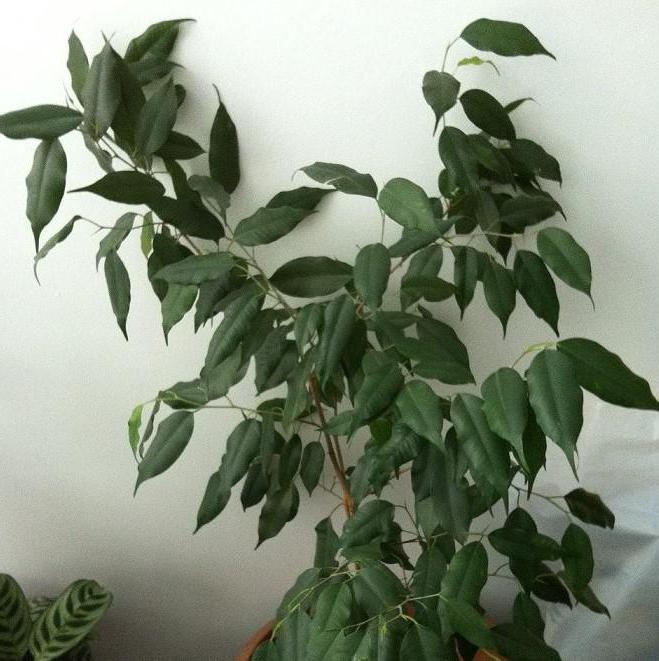

Diseases. Table
| Disease | Signs | The reasons | Treatment |
| Anthracnose | Dark brown spots appear on the leaves | The disease is provoked by pathogenic fungi Kabatiella, Colletotrichum, Gloeosporium | Remove the affected parts of the ficus, spray it with fungicides ("Rovral", "Fitosporin") |
| Root rot | Yellowing and wilting of foliage, rotting roots | Systematic waterlogging combined with cold air | Remove the ficus from the flowerpot, examine the roots. If they are dark and soft, the plant cannot be saved. Otherwise, it is necessary to cut off the damaged parts, transplant, replacing the soil and flowerpot, treat with fungicides ("Alirin", "Fitosporin", "Carbendazim") |
| Cercosporosis | The leaf plates are covered with small black dots below | The causative agent of the disease is the fungus Cercospora spp | Remove infected leaves, reduce watering, treat with "Alirin" or "Fitosporin" |
The soil
The selection of the right soil is an important point for growing indoor plants.
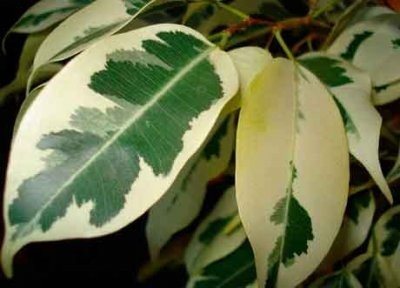

Ficuses are not very sensitive to the composition of the soil, but still there are certain requirements for them.
The substrate should be neutral or slightly acidic, breathable, and good moisture retention.
A mixture with a high clay content is definitely not suitable. Moisture stagnation will occur in it, which will cause decay of the roots.
A different composition is selected depending on the age of the plants.
Young specimens maximum looseness is needed, and for adults the soil should be dense enough.
Composition for young specimens - leaf humus, peat, sand in equal amounts.
For adults - humus, turf, peat, sand (1: 1: 1: 1) or humus, turf, sand (2: 2: 1).
The required looseness is also achieved by adding a small amount of expanded clay.
These porous stones provide air permeability, absorb moisture and fertilizers, and then gradually share them with the roots.
The addition of vermicompost stimulates the growth of ficus, improves survival in new soil.
Lime or dolomite flour must also be added to the soil. These minerals deoxidize it and enrich it with magnesium and calcium.
You can add wood ash, it also contains trace elements.
Advice: if you do not have the opportunity to prepare such mixtures, purchase ready-made, widely represented in retail chains. The composition is always indicated on the package, and you can make the right choice to ensure maximum comfort for your pet.
Indoor varieties
Ficus Benjamin has a huge variety of varieties, differing in size, shape and color of leaves, shape of the stem. Let's consider some of them.
- Exotic. The leaves are flat and soft, the color is deep green, the length is up to 8 cm, the width is up to 3.5 cm. The internodes are up to 4 cm. The bush grows quickly.
- Daniel. The leaves are dark green, solid, glossy, dense and flat, with straight edges. It grows very quickly - it grows almost 30 cm per season.
- Monique. Differs in more delicate, thin, hanging branches and light, elongated, slightly wavy leaves along the edge.
- Nicole. The leaves are more elongated, with a light edge.
- Safari. The variety is distinguished by a tricolor coloration and distinct spotting.
- Baroque. It is considered the most unusual, original and difficult to grow variety. Each leaf of this very tiny plant is twisted in a spiral.
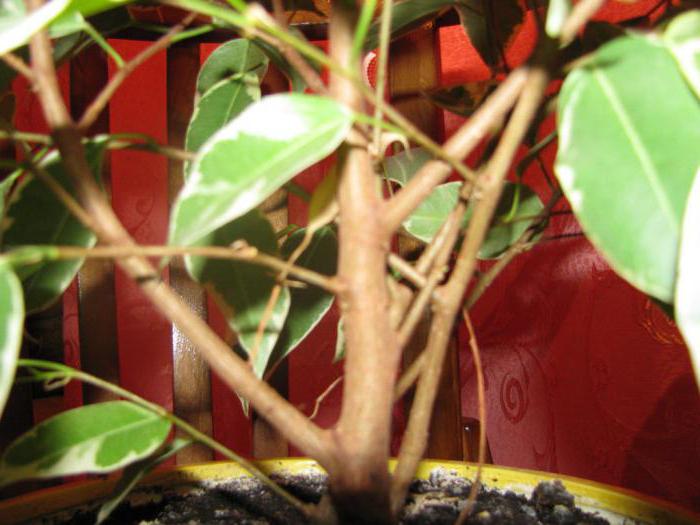

Beneficial features
This plant is used not only for decorative purposes. The useful properties of ficus include the following:
- Purifies indoor air by saturating it with oxygen.Ficus converts harmful elements into amino acids.
- It is used to treat malignant diseases, articular pathologies, hematomas, gynecological problems. The most useful is the rubbery ficus.
- Used to treat hemorrhoids. To combat the disease, frozen juice is used.
- It is used for the preparation of alcoholic medicines that help with pathologies of the oral cavity.
- Protects the home from negative energy.
Care and cultivation
To ensure the full development of the ficus, it needs comprehensive care. To do this, it is worth watering and feeding the culture on time.
Watering
Ficuses need water throughout the year. They love regular soil moisture. It is important to ensure that the soil does not dry out. There must be a drainage layer in the pot.
Ampelny
These ficuses should be watered often enough. You can suspect a moisture deficit by yellowing and discarding leaves. In this case, an excess of liquid entails rotting of the root collar, which provokes the death of the roots and even the death of the culture.


Tree-like
Such plants require less moisture compared to ampelous plants. They allow slight drying of the ground surface.
In winter
At this time, ficuses require careful watering. Excess moisture is dangerous for them. This is especially true when kept in a cool room.
In summer
In the summer, the ficus should be watered often enough. The plant can suffer from a lack of moisture.
Fertilizers and feeding
To grow a beautiful flower, you need to feed it on time. It is recommended to apply fertilizers once every 2 weeks. First, the bush should be watered abundantly. It is best to choose products that contain a lot of nitrogen. Fertilizers are applied from March to October - during the period of active vegetation and flowering.
In winter, it is also sometimes recommended to use nutritional formulations. However, this is done at most once a month. To fertilize the ficus, it is worth using such agents as Palma, Ideal, Humisol. The proportions of using the dressings are indicated in the instructions.
Transfer
When growing ficus at home, it should be transplanted periodically. Plants younger than 4 years old are recommended to be moved to a new pot each year. Subsequently, the procedure is performed every 2 years. In this case, it is worth periodically changing the topsoil. A planned transplant is carried out with the rapid drying of the earth and the appearance of roots on the surface.
See also
Selection criteria and description of fast-growing climbing plants for collection, planting and care
In this case, you should take a new pot. Its diameter should be 2-3 centimeters higher than the previous one. If you use too large a container, roots and stems will develop too slowly. For ampelous ficuses, pots are used.


Before planting, the soil is prepared. To do this, you can purchase ready-made land or make a mixture yourself. It is recommended to place a drainage layer on the bottom. A healthy plant is transferred to a new container by the transfer method. In this case, the earthen lump can be saved. If pests appear in the soil, it is worth getting rid of the old earth.
If the bush is too large, it is divided into several trunks. At first, it is recommended to water the plant abundantly. After transplanting, soil moistening is not required. At this stage, the flower is fed and transferred to a lighted place.
Pruning
This procedure is used to properly form the crown of the plant. Thanks to pruning, the bush begins to develop in width. In addition, manipulation helps to cope with diseases and has a rejuvenating effect on the flower.
Pruning can be standard, sanitary, anti-aging. Pinching or pinching is also carried out. The standard procedure is performed in the spring or late fall. In this case, it is permissible only to cut off the top.This contributes to the formation of the crown, stopping the growth of the bush upward, activating the emergence of new branches.
When carrying out sanitary manipulation, it is worth getting rid of dry and affected branches and leaves. Rejuvenating pruning is required when the plant freezes or leaves are lost. In this case, the bush should be cut off completely, leaving only 3-4 centimeters of the trunk. As a result, you will be able to get a new tree.
Pinching is considered a gentle procedure that aims to renew the upper kidneys. Before carrying out the manipulation, the bush should be carefully examined and identified the places that need to be removed. Pinching a flower is permissible at any time of the year.
To form the crown, various means are used that help direct the branches in the right direction. It is permissible to tie up shoots with ordinary laces. They can be braided or curly cut.
Water requirements
Hard or cold water should not be used for watering ficus. To soften the liquid, it can be boiled, filtered, and defended. It is also allowed to freeze and melt water, add softening compounds to it. Soft spring water works well for irrigation.


It is recommended to settle the water for at least 6 hours before watering. This will help get rid of impurities, which will make the liquid softer. Melt water is also a good option. It changes its structure, which helps to cleanse from bad substances.
"Spiral", or "hedge"
This is a circular ficus weave, it looks very attractive. It is easier to form such a composition than a "pigtail" or "lattice".
To create a "spiral" perform the following steps:
- A strong support is placed next to the cuttings.
- As the trunk grows, it is wound on a support. The side branches are cut off.
- When the bush has stopped growing, the support is removed. If the trunks are intertwined, the composition is ready.
To create a hedge, follow these steps:
- Young ficuses are planted in a row at the same distance between plants.
- As the flowers grow older, they are intertwined in random order.
Frequent mistakes during transplantation
The most common mistakes that breeders make when transplanting ficuses:
- plant transplant immediately after purchase;
- use of store-bought soil without preliminary disinfection;
- watering with cold water;
- applying dressings immediately after transplanting;
- placement of containers with a transplanted plant in a brightly lit room.
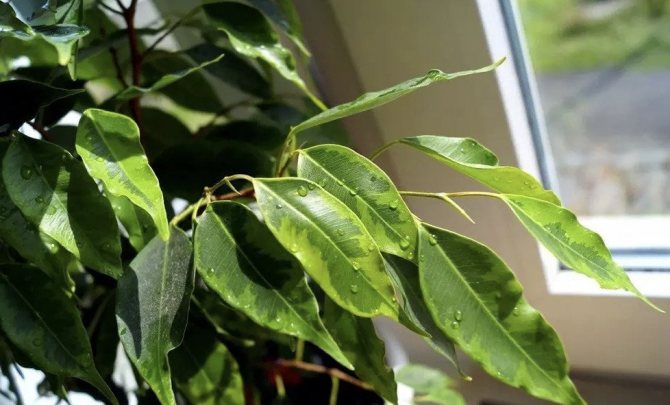

The most difficult agronomic measure for home cultivation of ficuses is transplantation. Compliance with all the rules regarding the timing and microclimate regime will help to avoid the difficulties associated with the adaptation of the plant to the new soil.
Watering
The regularity depends on the conditions of the plant. It is necessary to focus on the degree of drying out of the soil - if the earthen lump is dry at a depth of 2-3 cm, watering is required.
The water should be at room temperature, separated or filtered.
If you are going on vacation
During a long absence, it is worth using wick watering - put one end of a cord made of a fabric that absorbs moisture into a container of water, and the other end spirally on the soil surface around the plant and lightly sprinkle it with soil.
Drainage
Ficus requires a good drainage system, because when moisture stagnates in the soil, the root system begins to rot. In addition to the holes in the lower part of the pot, it is necessary to organize a drainage bedding made of expanded clay, crushed stone or pebbles.
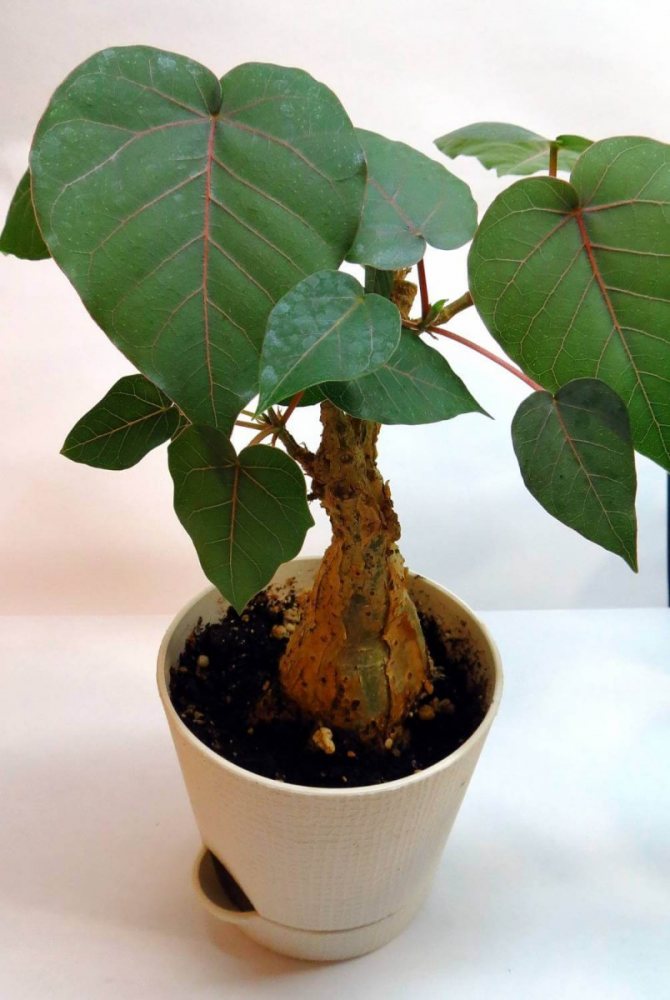

When organizing drainage, it should be ensured that the holes in the bottom of the pot are not blocked, and the water flows freely.

